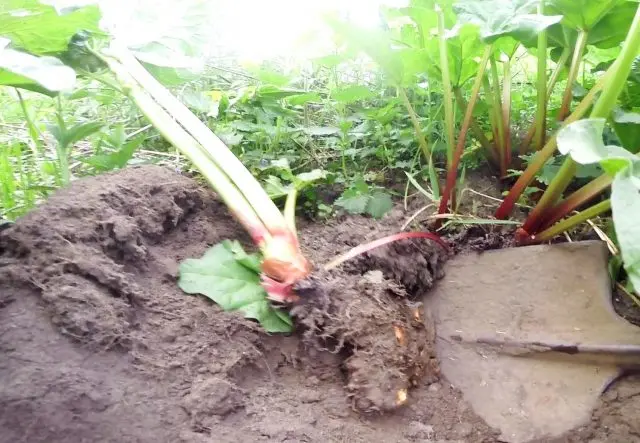Contents
Probably, everyone has known an unusual garden plant since childhood, resembling burdock with its foliage. But unlike wild burdock, it is eaten. A simple look and a pleasant sour taste – this is the peculiarity of rhubarb. And more and more often today gardeners plant it on their plots. But they are concerned not only with the rules of cultivation, but also with the collection of rhubarb itself. After all, such a plant has its own characteristics, which should be observed when collecting it for food or for medicinal purposes.

When can you harvest rhubarb stalks?
In the last month of spring, in May, rhubarb begins to grow from the ground. At this point, its petioles are very thin and fragile, holding young leaves. They are quite long and have a pink tint. It is at this time that rhubarb should be harvested for food.
Young petioles of this plant contain a sufficient amount of useful trace elements, including organic acids. At the same time, they are used not only for food, but also for medicinal purposes. But if we talk about the use in cooking, then the petioles can be consumed raw and cooked. There are a large number of recipes, for example, jam, jelly and even pastries.
How to harvest rhubarb stalks
In order for the rhubarb petioles to have all the taste qualities when harvested, to be useful for humans and at the same time harvesting does not harm the plant, some rules should be followed:
- The basic rule of collection is the choice of a young plant. Petioles should be tender, rather fragile and quite juicy. Therefore, the collection should be carried out in May and with re-growth, which occurs in mid-July. Eatable petioles are those that have a length of 20 to 80 cm, and their width should be no more than 1,5 cm.
- The petiole should be torn off at the very base, it should not be broken. It is necessary to tear off smoothly, without sudden movements, gently grasping the base and twisting slightly. If there are difficulties in this process, then you can carefully cut the petiole to the very base.
- It is strongly not recommended to collect all the leaves of rhubarb, as the plant may die. For normal growth and development, 5-6 leaves should be left, two of which should be young.
- It is impossible to collect rhubarb petioles for food during its flowering. Therefore, to increase the collection time, you can remove the stems of the peduncle.
When to Harvest Rhubarb Root
Quite often, rhubarb roots are used for medicinal purposes. Harvesting rhubarb roots should be done in the spring before the shoots appear, or in late autumn, when, on the contrary, all the leaves have already died. The process of dying off the leaves falls on the period from September to October. It is during this period that digging up a root for a plant will be a less traumatized process.

What are rhubarb roots used for?
Rhubarb root has long been used as an excellent therapeutic and prophylactic natural remedy, which has a mild laxative effect, helps get rid of toxins and allows you to normalize the digestive tract.
Due to the content of anthraglycosides in the root, it is used for the following purposes:
- to increase appetite and normalize the digestive tract;
- with constipation;
- to cleanse the body of toxins, biological poisons and fats;
- to combat excess weight;
- to suppress depression;
- to speed up the recovery process after fractures;
- with arthritis;
- for the treatment of hepatitis and other liver diseases;
- to prevent the occurrence of cancer.
Sometimes rhubarb root is recommended for menopause.
But it is worthwhile to understand that the root has a different effect on the body, depending on which remedy will be used. For example:
- In liquid form, rhubarb extract obtained from its root is used as a laxative. But in a small amount in tablet form, this extract can have the opposite effect, acting on the body as a fixing agent.
- Vinegar root tincture helps in the treatment of serious diseases such as vitiligo or psoriasis.
- An infusion of root powder with water helps in the treatment of the liver, providing a choleretic effect.
- Pureed fresh root helps in the care of the skin of the hands and face.
- With the help of a decoction of the root, you can prepare a healing hair dye that will strengthen and heal them.
How to collect correctly
There are no special instructions for collecting rhubarb roots, the main rule of digging is the minimum damage to the plant. To do this, it is necessary to dig it out from the very edge of the bush so as not to deform the entire root system.
The dug out root must be thoroughly cleaned from the ground, petioles, lateral and small roots should be cut off from it. After it is thoroughly washed under cold running water and laid out in a sunny place to dry.
How to dry and store
Harvested and dried rhubarb can be used raw or dried. In the dried state, the shelf life of rhubarb root increases to 3 years without losing its healing properties.
Drying must be carried out in a well-ventilated area in the open air. You can also perform this process using an electric dryer at a temperature of 50-60 degrees. Properly dried roots should be very light and brittle.
Store them in a cool dry place. This can be done in a wooden, cardboard or fabric container. The main requirement during storage is to maintain a constant level of humidity so that the product does not become damp.
Conclusion
Rhubarb can be harvested for a variety of purposes. But it is imperative to follow the rules for collecting both the petioles and the roots of this plant, so that the harvest brings only benefits.









